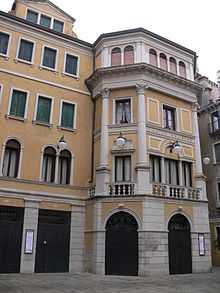Teatro Malibran

The Teatro Malibran, formerly known as the Teatro San Giovanni Grisostomo, is an opera house in Venice known for its operatic importance in the 17th and 18th centuries. Richly decorated, the theatre consists of five levels of thirty boxes and a large stalls area.
History

Designed by Thomas Bezzi for the Grimani family, the theatre was inaugurated during the 1678 carnival with Vespasiano by Carlo Pallavicino. It became the biggest, most luxurious and extravagant stage in Venice, known for its sumptuous productions and high quality singers such as Margherita Durastanti, prima donna between 1709 and 1712. During its golden age composers such as Carlo Francesco Pollarolo, Alessandro Scarlatti and Georg Friedrich Händel were active at the theatre.
During the 1730s, the San Giovanni Grisostomo began a slow and inexorable decline, although managing to keep its position at the head of Venetian theatres until the middle of the eighteenth century. In 1737, when Carlo Goldoni was placed in charge of the Venetian stage, prose works began to be performed (many of these his own comedies). Subsequently, because of its considerable size, the Grimani family decided to open a smaller theater in 1755, the San Benedetto. The opening of this new stage led to the end of the dominance of San Giovanni, which saw a slow decrease in performance.
Teatro Malibran
Following the French occupation of Venice, the theatre was among the few not to be closed. In 1819 it was sold to Gallo, who restored it in 1834; in 1837 he changed the name to Teatro Malibran, in honor of the famous singer Spanish mezzo-soprano Maria Malibran. In 1849 the return of the Austrians to Venice provoked the closure of all the major theatres of Venice as protest, with the exception of the Malibran.
After changing hands again in 1886, it reopened in 1913; after a single operatic season, it closed again due to security problems. Reopened in 1919, it was active in the showing of operas, operettas, and films for the first half of the century. In 1992 the municipality of Venice purchased the theater, which, after restoration and expansion, brought it back into use. Following the 1996 fire that destroyed the Teatro La Fenice, the Malibran was the temporary home to the Fenice orchestra.
The theatre was re-opened in 2001 by President Carlo Azeglio Ciampi.
Premieres
- Mitridate Eupatore, opera seria by Alessandro Scarlatti, 5 January 1707
- Agrippina, opera seria by George Frideric Handel, 26 December 1709
See also
- Opera houses and theatres in Venice
- List of opera houses worldwide
External links
Coordinates: 45°26′08″N 12°20′04″E / 45.435431°N 12.33453°E